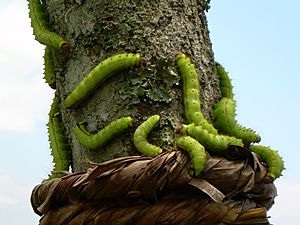Wild silk facts for kids
Wild silks are special types of silk. People have used them for a very long time in many parts of the world. They come from silkworms that live in nature, not on farms. We make much less wild silk compared to silk from farmed silkworms.
What Are Wild Silks?
Silk has been used since ancient times. People found ways to use silk from different insects. For example, in ancient Greece and Rome, spider webs were used to help heal wounds. In the Aztec Empire, people even made fabric from caterpillar nests.
To make fabric, silk threads must be prepared. They can be combed and spun into yarn. Or, they can be carefully unraveled as one long thread.
How Silk is Made
Most silk we use comes from farmed silkworms. These are a species called Bombyx mori. To get a long, continuous thread, the silkworms are usually kept from turning into moths. This is done by pricking their cocoons or putting them in hot water. This way, the whole cocoon can be unwound as one very long, fine thread. This makes it possible to weave a smooth, fine cloth.
There are over 500 types of wild silkworms around the world. But only a few of them are used to make cloth. Wild silks are often tougher and not as smooth as silk from farmed silkworms. This is because wild silk cocoons are usually collected after the moth has already left. When the moth breaks out, it cuts the silk threads. This means there isn't one long thread, but many shorter pieces.
Colors of Wild Silk
It is harder to make wild silks white or dye them bright colors. This is compared to silk from Bombyx mori. However, most wild silks have beautiful natural colors. A famous example is the muga silkworm from Assam, India. Its silk has a rich, shiny golden color. This is why it is often called Assam silk.
Wild silk cocoons are very strong. They are made tough by natural processes. Some are strengthened by a process called "tanning," which links the silk fibers together. Others have tiny minerals, like calcium oxalate, added to them. Scientists have recently found a new way to remove these minerals. This process is called demineralizing. It allows wild silk cocoons to be unwound like farmed silk, making it easier to get long threads.
See also
 In Spanish: Seda silvestre para niños
In Spanish: Seda silvestre para niños


